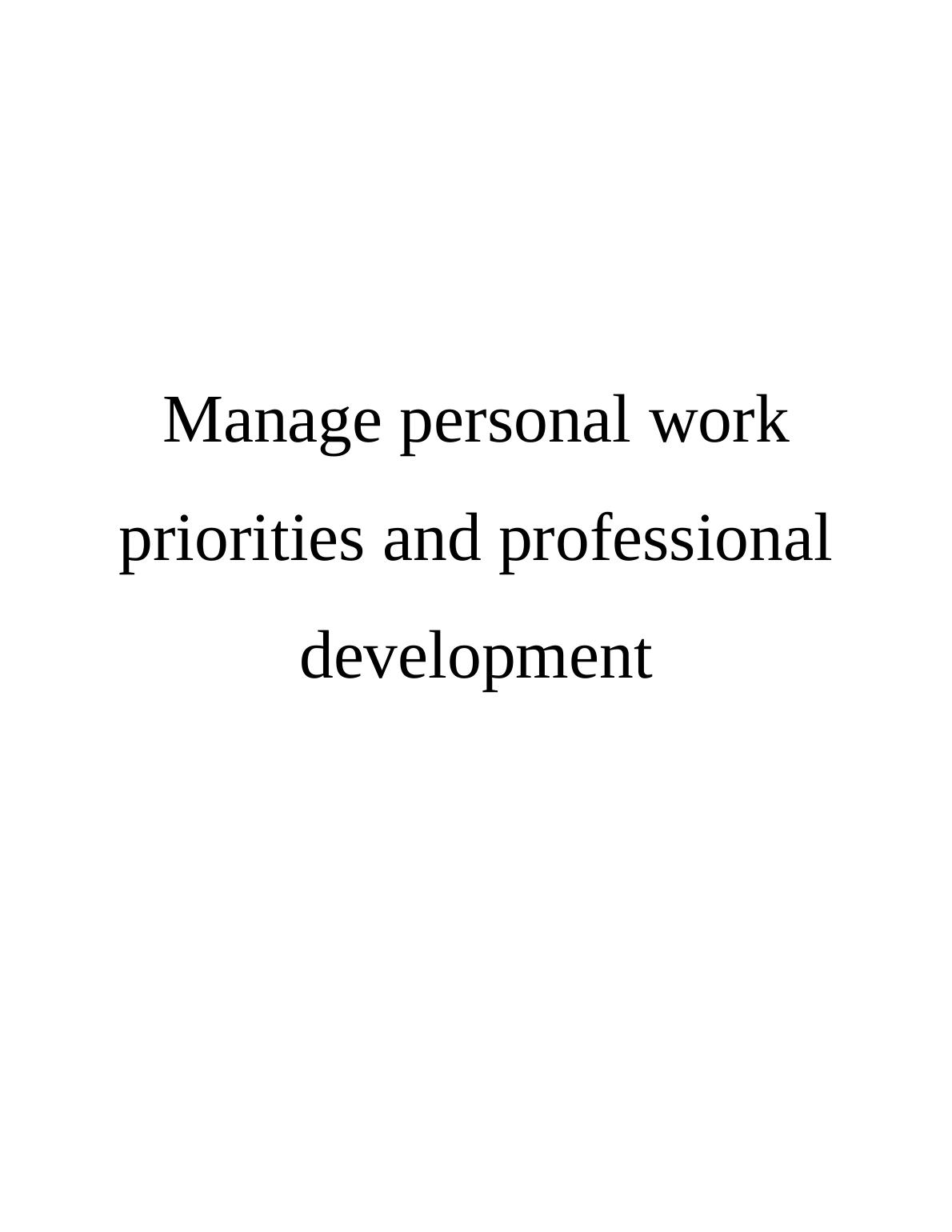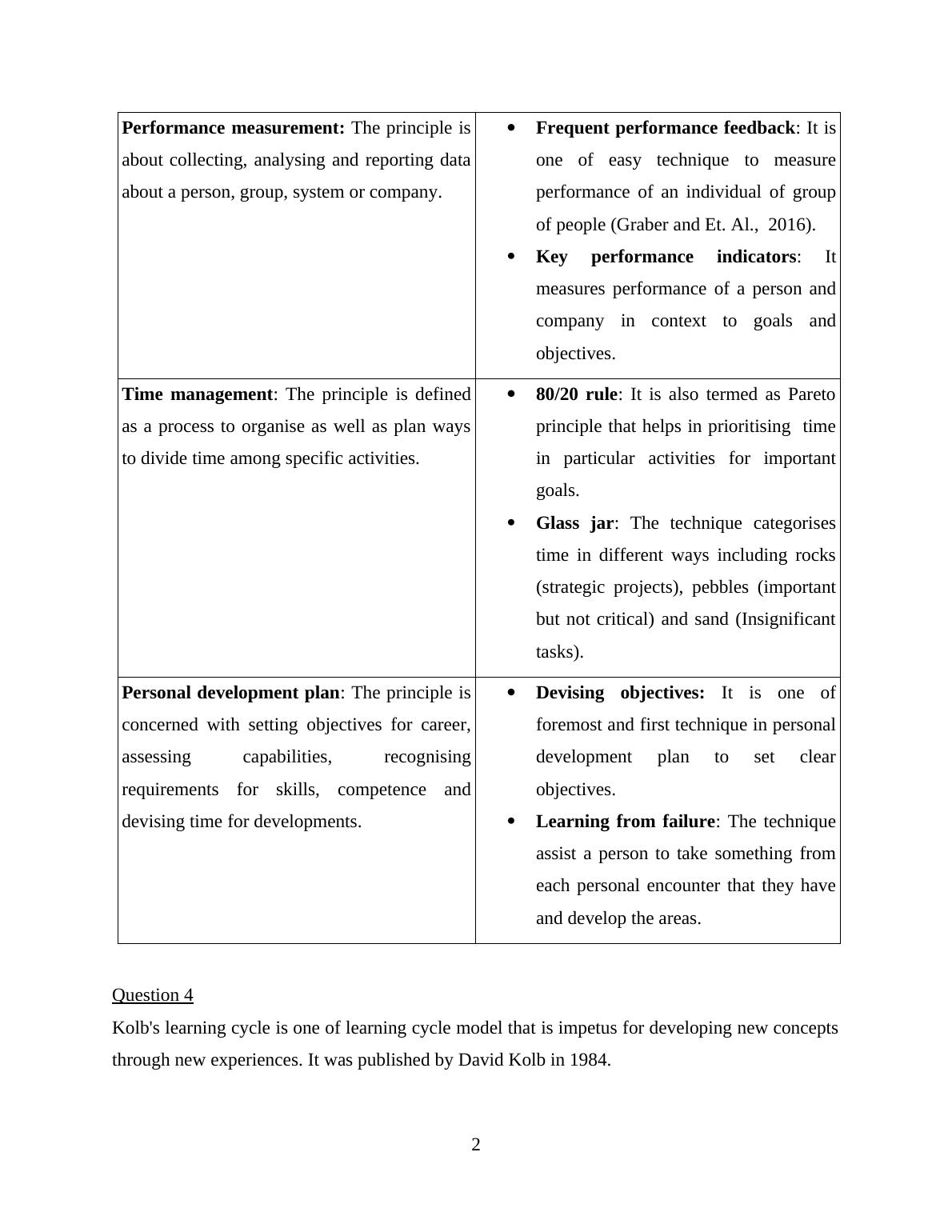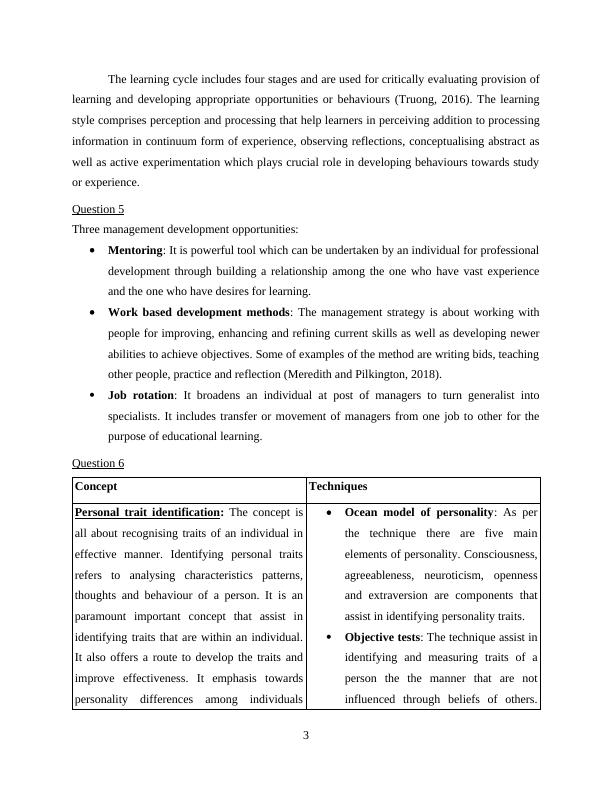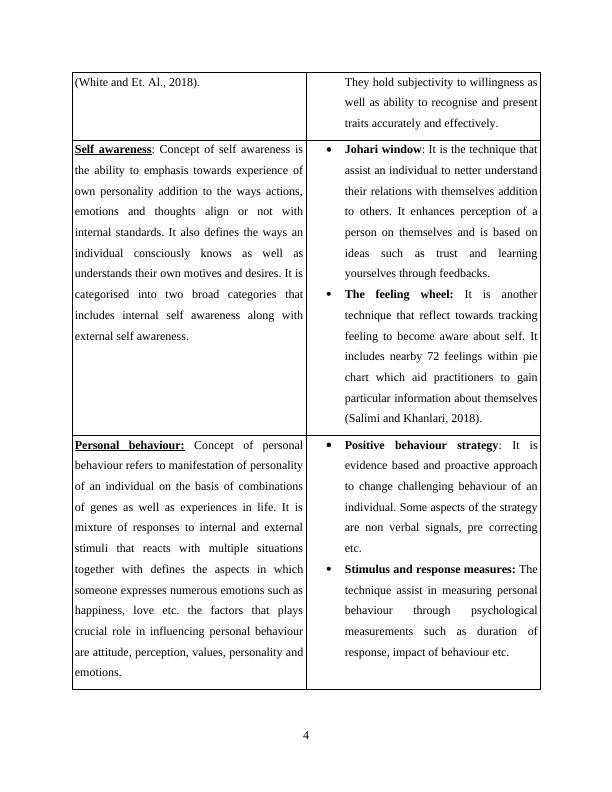Manage Personal Work Priorities and Professional Development
Added on 2023-01-07
29 Pages6934 Words7 Views
Manage personal work
priorities and professional
development
priorities and professional
development

Table of Contents
ASSESSMENT EVENT 1: WRITTEN QUESTIONS...................................................................1
Question 1....................................................................................................................................1
Question 2....................................................................................................................................1
Question 3....................................................................................................................................1
Question 4....................................................................................................................................2
Question 5....................................................................................................................................3
Question 6....................................................................................................................................3
Question 7 ...................................................................................................................................4
Question 8....................................................................................................................................5
ASSESSMENT EVENT 2: SIMULATION....................................................................................7
Task 1: Establish personal work goals.............................................................................................7
1.1 Development of work goal.....................................................................................................7
1.2 Ensure work goal aligns to the College plans and student responsibilities and
accountabilities............................................................................................................................7
TASK 2............................................................................................................................................8
2.1 Developing work plan............................................................................................................8
2.2 Implementing Work plan and measuring personal performance.........................................11
2.3 Prioritising competing demands..........................................................................................12
2.4 Monitoring and implementing contingencies in work plan.................................................15
2.5 Maintaining appropriate work life balance..........................................................................15
2.6 Ensuring stress is effectively managed................................................................................16
2.7 Ensuring health is managed.................................................................................................17
TASK 3..........................................................................................................................................17
3.1 Assessing personal knowledge as well as skills against competency standards for
identifying development needs..................................................................................................17
3.2 Seeking feedback from stakeholder in knowledge and skills..............................................19
3.3 Personal development plan..................................................................................................20
3.4 Implementing personal development plan .........................................................................21
REFERENCES..............................................................................................................................22
ASSESSMENT EVENT 1: WRITTEN QUESTIONS...................................................................1
Question 1....................................................................................................................................1
Question 2....................................................................................................................................1
Question 3....................................................................................................................................1
Question 4....................................................................................................................................2
Question 5....................................................................................................................................3
Question 6....................................................................................................................................3
Question 7 ...................................................................................................................................4
Question 8....................................................................................................................................5
ASSESSMENT EVENT 2: SIMULATION....................................................................................7
Task 1: Establish personal work goals.............................................................................................7
1.1 Development of work goal.....................................................................................................7
1.2 Ensure work goal aligns to the College plans and student responsibilities and
accountabilities............................................................................................................................7
TASK 2............................................................................................................................................8
2.1 Developing work plan............................................................................................................8
2.2 Implementing Work plan and measuring personal performance.........................................11
2.3 Prioritising competing demands..........................................................................................12
2.4 Monitoring and implementing contingencies in work plan.................................................15
2.5 Maintaining appropriate work life balance..........................................................................15
2.6 Ensuring stress is effectively managed................................................................................16
2.7 Ensuring health is managed.................................................................................................17
TASK 3..........................................................................................................................................17
3.1 Assessing personal knowledge as well as skills against competency standards for
identifying development needs..................................................................................................17
3.2 Seeking feedback from stakeholder in knowledge and skills..............................................19
3.3 Personal development plan..................................................................................................20
3.4 Implementing personal development plan .........................................................................21
REFERENCES..............................................................................................................................22

ASSESSMENT EVENT 1: WRITTEN QUESTIONS
Question 1
Tracking time: Keeping time log of all activities helps in building and maintaining
healthy life balance at work.
Schedule scrupulously: Through the strategy, people plan their work as well as work
their plan that help them in maintaining healthy work life balance. (Russo, Shteigman and
Carmeli, 2016)
Nurturing relationship: The strategy help in keeping personal relationship on priority
and establishing good relationship results in maintaining work life balance more
healthier.
Question 2
Reward high performance: Rewarding high performers is the work strategy that
motivates individual to work full fuller dedication, determination and efficiency.
Positive work environment: With this strategy, managers creates a favourable and
positive work environment in which individual gain improvements in their performances.
Simplifying complex processes: The strategy help an individual to work by simplifying
critical processes and improving performances.
Batching tasks as well as meetings: To achieve improvements in performances of
employees, popular strategy is “Batching the workings” (Hoerl and Snee, 2020).
Delegation: By delegation the work to an individual as per their preference is also a
strategy through which a person improves performances at work.
Question 3
Explaining the principle Explaining techniques
Personal goal setting: It is a powerful
principle in which an individual think about
ideal future as well as motivate themselves by
setting where they want to reach in their life.
SMART method: The technique is
effective for setting goals in personal
and academic life.
WOOP Method: The technique helps
in making dreams of a person comes
into reality.
1
Question 1
Tracking time: Keeping time log of all activities helps in building and maintaining
healthy life balance at work.
Schedule scrupulously: Through the strategy, people plan their work as well as work
their plan that help them in maintaining healthy work life balance. (Russo, Shteigman and
Carmeli, 2016)
Nurturing relationship: The strategy help in keeping personal relationship on priority
and establishing good relationship results in maintaining work life balance more
healthier.
Question 2
Reward high performance: Rewarding high performers is the work strategy that
motivates individual to work full fuller dedication, determination and efficiency.
Positive work environment: With this strategy, managers creates a favourable and
positive work environment in which individual gain improvements in their performances.
Simplifying complex processes: The strategy help an individual to work by simplifying
critical processes and improving performances.
Batching tasks as well as meetings: To achieve improvements in performances of
employees, popular strategy is “Batching the workings” (Hoerl and Snee, 2020).
Delegation: By delegation the work to an individual as per their preference is also a
strategy through which a person improves performances at work.
Question 3
Explaining the principle Explaining techniques
Personal goal setting: It is a powerful
principle in which an individual think about
ideal future as well as motivate themselves by
setting where they want to reach in their life.
SMART method: The technique is
effective for setting goals in personal
and academic life.
WOOP Method: The technique helps
in making dreams of a person comes
into reality.
1

Performance measurement: The principle is
about collecting, analysing and reporting data
about a person, group, system or company.
Frequent performance feedback: It is
one of easy technique to measure
performance of an individual of group
of people (Graber and Et. Al., 2016).
Key performance indicators: It
measures performance of a person and
company in context to goals and
objectives.
Time management: The principle is defined
as a process to organise as well as plan ways
to divide time among specific activities.
80/20 rule: It is also termed as Pareto
principle that helps in prioritising time
in particular activities for important
goals.
Glass jar: The technique categorises
time in different ways including rocks
(strategic projects), pebbles (important
but not critical) and sand (Insignificant
tasks).
Personal development plan: The principle is
concerned with setting objectives for career,
assessing capabilities, recognising
requirements for skills, competence and
devising time for developments.
Devising objectives: It is one of
foremost and first technique in personal
development plan to set clear
objectives.
Learning from failure: The technique
assist a person to take something from
each personal encounter that they have
and develop the areas.
Question 4
Kolb's learning cycle is one of learning cycle model that is impetus for developing new concepts
through new experiences. It was published by David Kolb in 1984.
2
about collecting, analysing and reporting data
about a person, group, system or company.
Frequent performance feedback: It is
one of easy technique to measure
performance of an individual of group
of people (Graber and Et. Al., 2016).
Key performance indicators: It
measures performance of a person and
company in context to goals and
objectives.
Time management: The principle is defined
as a process to organise as well as plan ways
to divide time among specific activities.
80/20 rule: It is also termed as Pareto
principle that helps in prioritising time
in particular activities for important
goals.
Glass jar: The technique categorises
time in different ways including rocks
(strategic projects), pebbles (important
but not critical) and sand (Insignificant
tasks).
Personal development plan: The principle is
concerned with setting objectives for career,
assessing capabilities, recognising
requirements for skills, competence and
devising time for developments.
Devising objectives: It is one of
foremost and first technique in personal
development plan to set clear
objectives.
Learning from failure: The technique
assist a person to take something from
each personal encounter that they have
and develop the areas.
Question 4
Kolb's learning cycle is one of learning cycle model that is impetus for developing new concepts
through new experiences. It was published by David Kolb in 1984.
2

The learning cycle includes four stages and are used for critically evaluating provision of
learning and developing appropriate opportunities or behaviours (Truong, 2016). The learning
style comprises perception and processing that help learners in perceiving addition to processing
information in continuum form of experience, observing reflections, conceptualising abstract as
well as active experimentation which plays crucial role in developing behaviours towards study
or experience.
Question 5
Three management development opportunities:
Mentoring: It is powerful tool which can be undertaken by an individual for professional
development through building a relationship among the one who have vast experience
and the one who have desires for learning.
Work based development methods: The management strategy is about working with
people for improving, enhancing and refining current skills as well as developing newer
abilities to achieve objectives. Some of examples of the method are writing bids, teaching
other people, practice and reflection (Meredith and Pilkington, 2018).
Job rotation: It broadens an individual at post of managers to turn generalist into
specialists. It includes transfer or movement of managers from one job to other for the
purpose of educational learning.
Question 6
Concept Techniques
Personal trait identification: The concept is
all about recognising traits of an individual in
effective manner. Identifying personal traits
refers to analysing characteristics patterns,
thoughts and behaviour of a person. It is an
paramount important concept that assist in
identifying traits that are within an individual.
It also offers a route to develop the traits and
improve effectiveness. It emphasis towards
personality differences among individuals
Ocean model of personality: As per
the technique there are five main
elements of personality. Consciousness,
agreeableness, neuroticism, openness
and extraversion are components that
assist in identifying personality traits.
Objective tests: The technique assist in
identifying and measuring traits of a
person the the manner that are not
influenced through beliefs of others.
3
learning and developing appropriate opportunities or behaviours (Truong, 2016). The learning
style comprises perception and processing that help learners in perceiving addition to processing
information in continuum form of experience, observing reflections, conceptualising abstract as
well as active experimentation which plays crucial role in developing behaviours towards study
or experience.
Question 5
Three management development opportunities:
Mentoring: It is powerful tool which can be undertaken by an individual for professional
development through building a relationship among the one who have vast experience
and the one who have desires for learning.
Work based development methods: The management strategy is about working with
people for improving, enhancing and refining current skills as well as developing newer
abilities to achieve objectives. Some of examples of the method are writing bids, teaching
other people, practice and reflection (Meredith and Pilkington, 2018).
Job rotation: It broadens an individual at post of managers to turn generalist into
specialists. It includes transfer or movement of managers from one job to other for the
purpose of educational learning.
Question 6
Concept Techniques
Personal trait identification: The concept is
all about recognising traits of an individual in
effective manner. Identifying personal traits
refers to analysing characteristics patterns,
thoughts and behaviour of a person. It is an
paramount important concept that assist in
identifying traits that are within an individual.
It also offers a route to develop the traits and
improve effectiveness. It emphasis towards
personality differences among individuals
Ocean model of personality: As per
the technique there are five main
elements of personality. Consciousness,
agreeableness, neuroticism, openness
and extraversion are components that
assist in identifying personality traits.
Objective tests: The technique assist in
identifying and measuring traits of a
person the the manner that are not
influenced through beliefs of others.
3

(White and Et. Al., 2018). They hold subjectivity to willingness as
well as ability to recognise and present
traits accurately and effectively.
Self awareness: Concept of self awareness is
the ability to emphasis towards experience of
own personality addition to the ways actions,
emotions and thoughts align or not with
internal standards. It also defines the ways an
individual consciously knows as well as
understands their own motives and desires. It is
categorised into two broad categories that
includes internal self awareness along with
external self awareness.
Johari window: It is the technique that
assist an individual to netter understand
their relations with themselves addition
to others. It enhances perception of a
person on themselves and is based on
ideas such as trust and learning
yourselves through feedbacks.
The feeling wheel: It is another
technique that reflect towards tracking
feeling to become aware about self. It
includes nearby 72 feelings within pie
chart which aid practitioners to gain
particular information about themselves
(Salimi and Khanlari, 2018).
Personal behaviour: Concept of personal
behaviour refers to manifestation of personality
of an individual on the basis of combinations
of genes as well as experiences in life. It is
mixture of responses to internal and external
stimuli that reacts with multiple situations
together with defines the aspects in which
someone expresses numerous emotions such as
happiness, love etc. the factors that plays
crucial role in influencing personal behaviour
are attitude, perception, values, personality and
emotions.
Positive behaviour strategy: It is
evidence based and proactive approach
to change challenging behaviour of an
individual. Some aspects of the strategy
are non verbal signals, pre correcting
etc.
Stimulus and response measures: The
technique assist in measuring personal
behaviour through psychological
measurements such as duration of
response, impact of behaviour etc.
4
well as ability to recognise and present
traits accurately and effectively.
Self awareness: Concept of self awareness is
the ability to emphasis towards experience of
own personality addition to the ways actions,
emotions and thoughts align or not with
internal standards. It also defines the ways an
individual consciously knows as well as
understands their own motives and desires. It is
categorised into two broad categories that
includes internal self awareness along with
external self awareness.
Johari window: It is the technique that
assist an individual to netter understand
their relations with themselves addition
to others. It enhances perception of a
person on themselves and is based on
ideas such as trust and learning
yourselves through feedbacks.
The feeling wheel: It is another
technique that reflect towards tracking
feeling to become aware about self. It
includes nearby 72 feelings within pie
chart which aid practitioners to gain
particular information about themselves
(Salimi and Khanlari, 2018).
Personal behaviour: Concept of personal
behaviour refers to manifestation of personality
of an individual on the basis of combinations
of genes as well as experiences in life. It is
mixture of responses to internal and external
stimuli that reacts with multiple situations
together with defines the aspects in which
someone expresses numerous emotions such as
happiness, love etc. the factors that plays
crucial role in influencing personal behaviour
are attitude, perception, values, personality and
emotions.
Positive behaviour strategy: It is
evidence based and proactive approach
to change challenging behaviour of an
individual. Some aspects of the strategy
are non verbal signals, pre correcting
etc.
Stimulus and response measures: The
technique assist in measuring personal
behaviour through psychological
measurements such as duration of
response, impact of behaviour etc.
4

End of preview
Want to access all the pages? Upload your documents or become a member.
Related Documents
Managing Personal Work Priorities & Professional Developmentlg...
|18
|4852
|273
BSBWOR501 - Manage Personal Work Priorities and - Deskliblg...
|30
|6666
|304
Principles and Techniques in Organizational Areaslg...
|7
|981
|91
Manage Personal Work Priorities and Professional Developmentlg...
|17
|3589
|42
Manage Work Priorities and Professional Development Assessmentlg...
|16
|3677
|76
Manage Personal Work and Professional Developmentlg...
|21
|4220
|41
